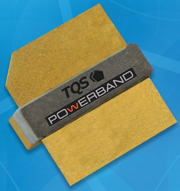
| Home | About Us | Contribute | Bookstore | Advertising | Subscribe for Free NOW! |
| News Archive | Features | Events | Recruitment | Directory |
| FREE subscription |
| Subscribe for free to receive each issue of Semiconductor Today magazine and weekly news brief. |
News
17 November 2008
TriQuint unveils high-efficiency, high-power wideband RF transistors
At the MILCOM (military communications) conference and exhibition in the San Diego Convention Center today, RF product manufacturer and foundry services provider TriQuint Semiconductor Inc of Hillsboro, OR, USA unveiled its new PowerBand family of high-power discrete RF transistors for broadband applications (including radar, signal jammers and wireless communications).
“A traditional high-power RF transistor is designed to operate across a narrow frequency range, such as 2.53-2.65GHz,” says PowerBand co-inventor Bill McCalpin, general manager of TriQuint’s Colorado Design Center (formerly Peak Devices Inc of Boulder, CO, for which McCalpin was CEO until it was acquired in September 2007). “Within that range, it delivers power relatively efficiently. But as bandwidth increases, performance falls,” he explains. Existing broadband market solutions therefore trade off performance (efficiency or power) to achieve wide-band service.
In contrast, PowerBand technology is flexible enough to be applied to most common RF transistor semiconductor processes, including not only silicon RF LDMOS (laterally diffused metal oxide semiconductor) but also gallium arsenide E/D (enhancement/depletion-mode) pHEMT as well as gallium nitride technologies. The first range of six PowerBand transistors launched at MILCOM consists of: a 30W LDMOS transistor operating at 500MHz-2.0GHz and 28V with a power added efficiency (PAE) of 60%, plus five pHEMT transistors with efficiencies of 50% - 30W and 50W pHEMTs operating at 28V and 500MHz-2.0GHz; a 20W pHEMT operating at 28V and 500MHz-2.5GHz; and 10W and 20W pHEMTs operating at 12V and 500MHz-2.7GHz and 500MHz-3.0GHz, respectively.
“PowerBand is totally different in its ability to deliver high power (up to 50W) and high-efficiency performance (50% power added efficiency, typical) across a much wider frequency range, from 500MHz to 3GHz [as measured in a broadband fixture],” McCalpin claims.
“PowerBand is disruptive technology, and as such there are sure to be some skeptics,” acknowledges president & CEO Ralph Quinsey. “But the proof is here. We’ve achieved results that are reproducible and manufacturable,” he states.
 TriQuint reckons that PowerBand enables savings in space, cost and energy. Because the technology efficiently delivers high power across what is claimed to be unprecedented bandwidth without the traditional sacrifices in efficiency or other key performance parameters, an RF design may require only one transistor line-up instead of several, cutting the bill of materials and size of end-user products by shrinking the space dedicated to RF, says Quinsey.
TriQuint reckons that PowerBand enables savings in space, cost and energy. Because the technology efficiently delivers high power across what is claimed to be unprecedented bandwidth without the traditional sacrifices in efficiency or other key performance parameters, an RF design may require only one transistor line-up instead of several, cutting the bill of materials and size of end-user products by shrinking the space dedicated to RF, says Quinsey.
Many broadband defense and military programs could benefit from new technology, reckons TriQuint. One PowerBand transistor amplifier line-up (containing 2-4 devices, covering an entire band) can replace three or more traditional transistor amplifier line-ups (each containing 2-4 devices). So, in typical applications, just 2-4 PowerBand devices could replace 6-12 conventional RF transistors.
PowerBand devices have been reviewed by companies that require high-power broadband RF transistors for their designs, including Milpower Inc of El Cajon, CA, USA, a supplier of RF power systems for defense, military and aerospace contractors. “The improved efficiency and bandwidth will pay system dividends in the form of less PCB area dedicated to RF, longer battery life, the opportunity to re-shape end products and reduce size, as well as less need for thermal management,” says Milpower’s senior development engineer Dean Schulze.
TriQuint says that PowerBand also enables greater efficiency for both mobile devices (extending battery life and reducing system over-heating) as well as ground-based RF networks infrastructure (reducing waste heat, which can cut power costs and carbon footprint from heat removal while also cutting the amount of equipment dedicated to thermal management). For both mobile and ground-based RF systems, PowerBand can allow a smaller bill of materials and inventory overhead, as well as simpler and faster assembly, reckons TriQuint. “This innovation can enable new usage models and cost points for a broad range of wireless products,” says McCalpin.
Prototype PowerBand devices and evaluation boards (enabling testing of performance across 500MHz–3GHz) are now available; product delivery is scheduled for second-quarter 2009.
See related items:
TriQuint introduces two high volume GaAs foundry processes for mmWave market
WJ boosts TriQuint’s 47% growth as profit triples
TriQuint claims smallest, most integrated GPS RF front-end module
TriQuint’s GaAs foundry process used for ICs in Large Hadron Collider
TriQuint wins $4.5m Navy contract to extend GaAs pHEMTs above 20GHz
Search: TriQuint Silicon RF LDMOS GaAs pHEMT GaN RF
Visit: www.triquint.com/powerband